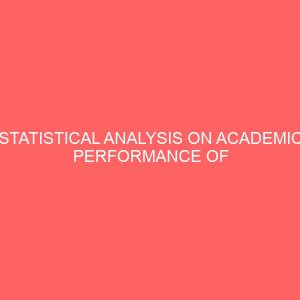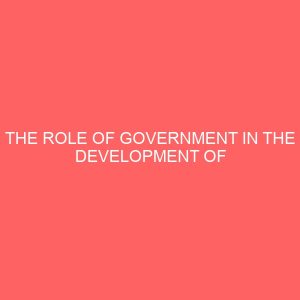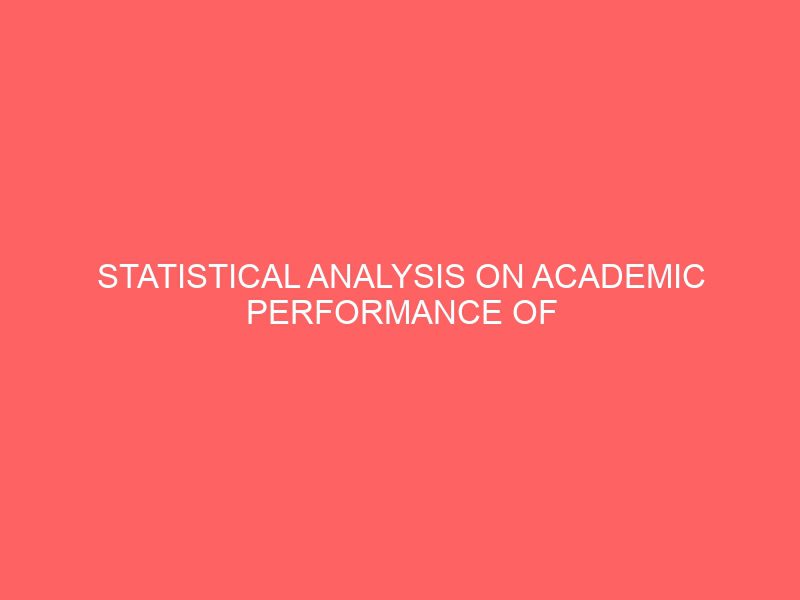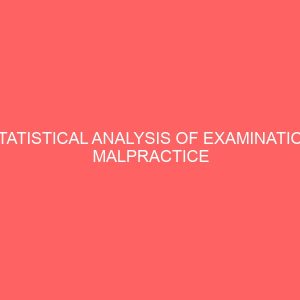Description
CHAPTER ONE
1.0 INTRODUCTION
This research is on Statistical analysis on academic performance of students in federal polytechnic offa. (A case study of applied science and technology and school of engineering). Education is generally regarded as a necessary and essential requirement for human development. It is central to socio-economic and technological advancements, and it is critical to self-generating process of positive transformation of modern society. Education is partially about primary socialization, partly about the process of impacting knowledge for process and development, both of the individual and group levels. Education is not just about literacy and enlightenment. It is about the value formation, value generation and orientation. Thus, education is complete process of setting the context for societal self-definition and reproduction. According to the researcher Bello Taofeeq .O. continued to shed more about the performance of the student, is dependent the type of their schools.
1.1 LEARNING IN NIGERIA
Nigeria has indigenous form of education, Qu’ranic schools and the western educational institutions. The indigenous forms of education include participation in community life to train young people in farming and other occupations. Qu’ranic education is carried out in religious schools called Mediassah. Children learn sections of the Qur’an (the Holy book of Islam)from the local Alfas or Islamic teachers, Qu’ranic education also includes learning to read and write in Arabic. Although some students go on to specialize in Arabic studies, most children who participate in Qu’ranic education proceed to the Western schools.
Nigeria was one of the African countries under the British colonial masters. However, in the 19th century, the missionaries came to Nigeria and introduced the Western education which marked the birth of formal education in the country. The major interest of the missionaries was to spread Christianity by the establishment of churches and schools. The sole idea that midwives the establishment of schools was to make as many people as possible literate, so as to enable them read and improve level of understanding of the Bible which would assist them in the propagation and proclamation of Christianity. The language of instruction was either English or one of the local languages. Teaching at the secondary and post-secondary levels is always in English. About 76% of the Nigeria children attend the primary school, while only 23% attend the secondary.
1.2 EDUCATION SYSTEM IN NIGERIA
The education system in Nigeria requires six years of primary education, a two-tier (three years junior, three years senior) secondary education i.e. junior secondary school and senior secondary school, and four years of tertiary education. This was found in 1982. At the completion of secondary school education, student sits’ for the senior secondary school certificate examination, and if successful, depending on his/her interest and performance or aptitude, has the option of proceeding to colleges of education, Technical colleges, Polytechnics and University for further studies. Nigeria has a literacy level of about 60%. To improve the situation further, the present administration scheme retaining the primary education at six years but making it compulsory and free for all Admission into secondary school is based on a common entrance examination. The junior school certificate is awarded after the first three years. When the student sits and passes the senior secondary examination at the expiration of the second three years, they are awarded the certificate. The certificate in the junior and school awarded based on an examination conducted by the West African.
Examination Council (WAEC) . Vocational education produces middle level manpower and it is offered in Technical College or Businesses and Engineering. Skill trained Center. Technical Colleges are the only alternatives to senior secondary school, as a route to further formal education and training after the junior secondary education. To gain admission into the higher institution students have to pass the University Matriculation Examination (UME).
1.3 GROWTH OF EDUCATIONAL IN NIGERIA
Progress in educational was slow but steady throughout the colonial era until the end of the World War II. By 1950 the country had developed a three tier system of primary, secondary and higher education based on the British model of wide participation at the bottom sorting into academic and vocational training at the secondary level, and higher education for small elite destined for leadership. In the North, primary school enrolment rose from 66,000 in 1947 to 206,000 in 1951. In the West (mostly Yoruba area) enrolment roses from 240,000 to 983,000in the same period, and in the East from 320,000 to 1,209,000. Secondary level enrolment rose from 10,000 for the country as a whole in 1947 to 36,000 in 1951. In 1957, 90% of these however were in the south. Given the central importance of formal education, it soon became “the largest social programme of all governments of the federation,” absorbing as much as 40% of the budgets of some state governments.
1.4 CRISES OF EDUCATION IN NIGERIA
Growth in Nigeria was impossible without incurring a lot of problems, several of which were to serve as to endanger the entire system of education as long as the country was growing space in terms of jobs for the educational minority through investment in expanding government agencies and services and the private sector, the growing number of graduate could be absorbed. But the criteria for access to schools and universities led to widespread corruption and cheating among students at all levels, but especially secondary and post-secondary. Economic hardship among teaching staffs produced increased engagement in non-academic activities. Added to these difficulties were factors as lack of books and material, no incentive for materials, and the negligence of replacement of laboratory equipment. In this paper, we would like to investigate if:
- A students’ sex had any effect on their academic performance towards getting a certificate.
- A student’s age could affect their attaining a high level of academic performance.
- There is a relationship between the population of students and their performance
At the end of our investigation we will be in a position to make adequate suggestions and recommendations to appropriate bodies concerning the criteria to apply in the future for admission to the polytechnic.
1.5AIM AND OBJECTIVES OF THE STUDY
The general aim of this study is to compare the academic performance of student in School Applied Science and Technology and School of Engineering.
The objectives are:
- To know whether the academic performance of the students is depend on the type of their schools.
- To know whether there is a significant difference between the scores of the students in school of engineering.
1.6STATEMENT OF THE PROBLEM
Problem solving is an integral component of our daily activities. Problem must exist before solution. Research study deals essentially with identification of problem and providing solution to the identified problem. The statement of the problem for this research work goes thus.
1.7 STATEMENT OF HYPOTHESIS
A problem statement cannot be scientifically solved except it is stated in hypothesis because a problem is usually of a broad nature. So base on the statement of the problem, the following hypothesis are derived.
- Academic performance of the students is depending on the type of their schools.
- There is a significant difference between the students’ performance in the School of Applied science and engineering.
1.8 SIGNIFICANT OF THE STUDY
The focus of any research works should be on how to provide solution to the identify problem and to bring out some importance of the research work.
- This research work will help the ministry of education to know the causes of poor performance of school of engineering in order to improve on those causes.
- The comparison of this academic performance will serve as importance parameter for the school,government and the people as a whole in making decision.
- It can be used for future research on the related study.
- It also adds more knowledge to the knowledge of the research.
1.9 SCOPE OF THE STUDY
The geographical area of coverage of this research work is the academic performance of students in federal polytechnic Offa in (2) two selected school that is four selected departments are:
SCHOOL OF APPLIED SCIENCE
- Mathematics and Statistics
- Computer Science
SCHOOL OF ENGINEERING
- Mechanical Engineering
- Computer Engineering
1.10 LIMITATION OF THE STUDY
This is to do with the problem encountered during the course of study and they are:
- FINANCIALPROBLEM: – This is the major problem faced by any researcher, for a researcher to be adequate there must be enough of fund.
- TIME FACTOR: – Since the researcher work is intensive in nature, require physical and mental work which does not call for division of labor, the researcher ability to meet up with the collection of necessary information for this research work was restricted due to time constraints.
- NON-DISCLOSURE/AD-HORE: – Some of the lecturers refused to disclose the necessary information needed due to their believes that the information collected will not be kept confidential.








Reviews
There are no reviews yet.